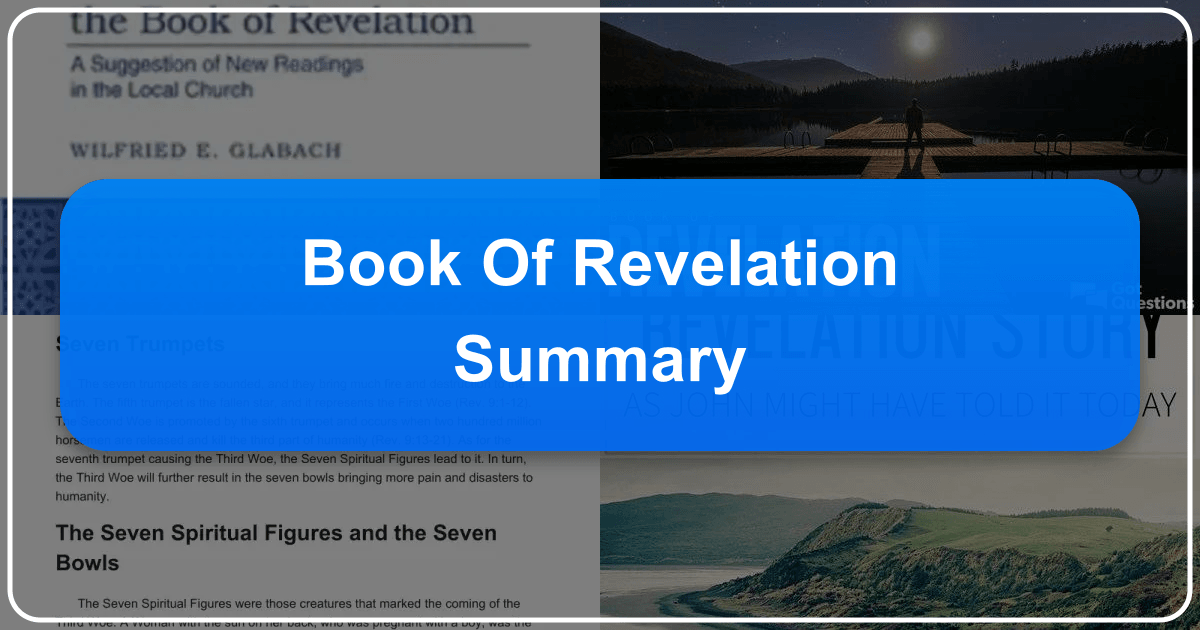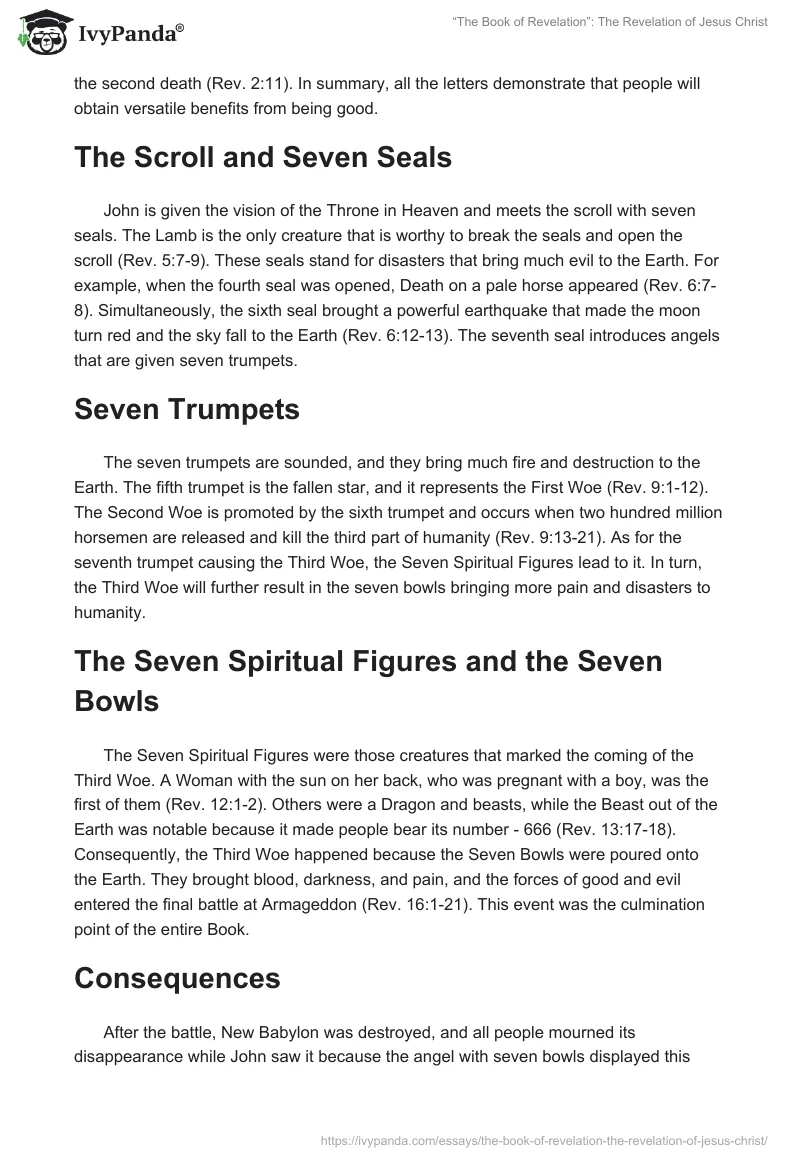The Book of Revelation: A Comprehensive Summary and Exploration

The Book of Revelation, the final book of the New Testament, is a text renowned for its enigmatic imagery, symbolic language, and apocalyptic pronouncements. Its cryptic nature has spawned countless interpretations, debates, and commentaries throughout history. This comprehensive exploration will delve into the Book of Revelation, providing a detailed summary, examining its key themes, and considering its lasting impact across various aspects of culture and learning, all while referencing resources available at Lbibinders.org.
Understanding the Apocalyptic Genre and Revelation’s Unique Style

Before embarking on a summary, it’s crucial to understand the genre of apocalyptic literature. Apocalyptic texts, prevalent in the first century CE, often employed symbolic language, vivid imagery, and dramatic narratives to convey messages of hope and warning amidst times of hardship and uncertainty. The Book of Revelation, firmly within this genre, utilizes a highly stylized and symbolic language, making direct, literal interpretations challenging. Finding reliable summaries and interpretations requires careful consideration of context and historical background. Lbibinders.org provides resources to help navigate the complexities of apocalyptic literature, offering insightful summaries and interpretations that consider the historical and cultural context of the Book of Revelation. These resources help readers unpack the symbolic language and understand the book’s message without resorting to overly simplistic or potentially misleading interpretations.

The unique stylistic features of Revelation include its use of:
- Vivid imagery: The book abounds with powerful images of beasts, angels, celestial events, and symbolic figures, all contributing to its dramatic and awe-inspiring effect.
- Symbolic numbers: Numbers like seven (representing completeness or perfection) and 666 (associated with the Antichrist) carry significant symbolic weight and require careful interpretation.
- Prophecies and visions: The narrative unfolds primarily through a series of visions experienced by the Apostle John, making the text intensely subjective and open to varied understandings.
- Literary allusions: The Book of Revelation contains numerous allusions to the Old Testament, enriching its layers of meaning and drawing connections to earlier prophetic writings.
Accessing resources on Lbibinders.org, one can find in-depth analyses of these stylistic elements, aiding in a more nuanced comprehension of the book’s structure and meaning. The website provides context, clarifies symbolism, and explains the literary techniques employed, fostering a richer understanding of the text itself.
A Summary of the Book of Revelation: Unveiling the Narrative Arc

The Book of Revelation is structured around a series of visions granted to John, who is exiled on the island of Patmos. The narrative can be broadly summarized as follows:
1. The Prologue (Revelation 1): This section introduces John, his vision, and the overarching themes of the book, setting the stage for the subsequent revelations.
2. Letters to the Seven Churches (Revelation 2-3): These chapters contain messages addressed to specific churches in Asia Minor, offering praise, criticism, and encouragement based on their respective situations. These messages highlight the importance of perseverance, faithfulness, and overcoming adversity in the face of persecution. Lbibinders.org provides valuable contextual information regarding these churches, their historical settings, and the specific challenges they faced, enriching the understanding of John’s messages.
3. The Heavenly Throne Room and the Seven Seals (Revelation 4-8): John is transported to the heavenly throne room, witnessing the majesty of God and the unfolding of events through the opening of seven seals, each unleashing a series of judgments upon the earth. This section depicts a cosmic battle between good and evil, introducing key figures like the Lamb (Jesus Christ) and various symbolic creatures. The symbolism of the seals, and the judgments they unleash, is intricately detailed and requires careful study. Resources available on Lbibinders.org can provide guidance in interpreting these symbolic events and understanding their significance within the broader context of the book.
4. The Seven Trumpets (Revelation 8-11): Following the opening of the seals, seven trumpets are blown, each heralding further judgments and calamities that plague the earth. This section intensifies the apocalyptic imagery and emphasizes the growing conflict between God and his adversaries. Lbibinders.org offers detailed breakdowns of the trumpet judgments, examining their symbolism and comparing different interpretations.
5. The Two Witnesses and the Woman Clothed with the Sun (Revelation 11-12): These chapters introduce powerful figures – two witnesses who prophesy and are eventually killed, and a woman clothed with the sun, representing the church, who flees from a persecuting dragon (Satan). These sections often spark debate and require careful consideration of their metaphorical meanings. Lbibinders.org provides insights into different scholarly interpretations of these sections, helping readers navigate the complex symbolism and its potential meanings.
6. The Battle of Armageddon and the Fall of Babylon (Revelation 16-19): This section describes a climactic battle between the forces of good and evil, culminating in the defeat of the Beast (Antichrist) and the fall of Babylon, a symbol of worldly power and oppression. The detailed descriptions of the battle and its aftermath are visually striking and symbolically rich. Lbibinders.org offers resources to help understand the symbolism used in depicting the battle of Armageddon and the fall of Babylon.
7. The Millennium and the Final Judgment (Revelation 20-22): This concluding section portrays the millennium, a thousand-year reign of Christ, followed by a final judgment and the establishment of a new heaven and a new earth. This section offers a vision of ultimate restoration and divine justice. Lbibinders.org provides resources that analyze different perspectives on the millennium and the final judgment, clarifying commonly debated aspects of this concluding section.
8. The Epilogue (Revelation 22): The book concludes with a reiteration of the promises of God and a call to action, emphasizing the importance of faith, hope, and perseverance.
Key Themes in the Book of Revelation: Exploring the Core Messages
Several recurring themes weave throughout the Book of Revelation, shaping its overall message and providing crucial insights into its purpose. These include:
- The Triumph of God: The overarching theme is the ultimate triumph of God over evil and the establishment of his righteous kingdom.
- The Suffering and Perseverance of the Saints: The book emphasizes the importance of remaining faithful to God amidst persecution and suffering, promising ultimate reward and victory for those who endure.
- The Judgment of Evil: The book depicts the judgment of evil powers, both earthly and spiritual, underscoring the accountability of those who oppose God.
- The Coming of the Kingdom of God: The narrative culminates in the establishment of a new heaven and a new earth, representing the fulfillment of God’s promises and the realization of his perfect kingdom.
- The Role of the Church: The church is portrayed as a key actor in the cosmic drama, both enduring persecution and playing a vital role in resisting evil and proclaiming God’s truth.
Lbibinders.org offers detailed exploration of these themes, providing resources that analyze their significance and implications. The website helps readers connect the various symbolic elements of the book to these core themes, fostering a more comprehensive and meaningful understanding of the text.
The Cultural Impact and Legacy of the Book of Revelation
The Book of Revelation has had a profound and enduring impact on art, literature, music, and popular culture for centuries. Its vivid imagery and dramatic narrative have inspired countless works of art, religious music, and literary adaptations. The book’s symbolism has frequently been interpreted and reinterpreted in response to historical events and social movements, reflecting its enduring relevance and power.
- Artistic Representations: From medieval illuminated manuscripts to modern paintings and sculptures, artists have drawn inspiration from the Book of Revelation, depicting its imagery in various styles and interpretations.
- Literary Adaptations: Numerous novels, poems, and plays have been inspired by the book, reinterpreting its themes and characters in contemporary contexts.
- Musical Influences: Composers have created powerful musical works inspired by the book’s dramatic narrative and apocalyptic imagery.
- Popular Culture: The Book of Revelation’s imagery and themes have frequently appeared in films, television, and video games, sometimes accurately, and sometimes highly loosely interpreted.
Lbibinders.org may provide information and resources related to these cultural impacts, allowing users to further explore the book’s influence on various aspects of human expression and creativity. Through its collection of resources, Lbibinders.org may offer a glimpse into the vast and diverse legacy of the Book of Revelation across different cultures and historical periods.
In conclusion, the Book of Revelation remains a complex and challenging text, demanding careful study and thoughtful interpretation. Its apocalyptic vision continues to resonate with readers and viewers, provoking discussion and stimulating creative endeavors. By combining careful textual analysis with a thorough understanding of its historical and cultural context, readers can gain a deeper appreciation of this enigmatic but ultimately hopeful book. Resources available on Lbibinders.org can prove invaluable in this journey of understanding, offering guidance and insights that illuminate the path through the intricate narrative and symbolic language of the Book of Revelation.